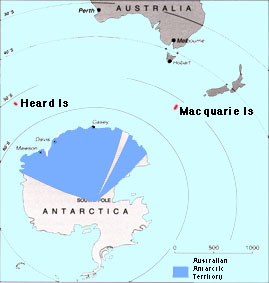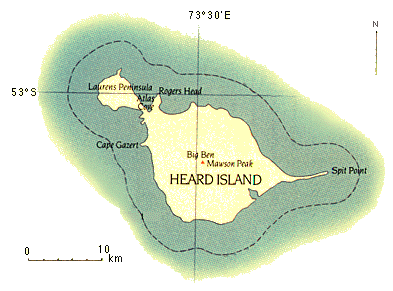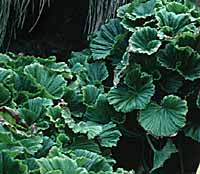![Director of National Parks [logo]](/images/dnp_90px.gif)


![Director of National Parks [logo]](/images/dnp_90px.gif) |
 |
 |
By 1991, two years after its initial collection of plants from Macquarie Island (previous article), Australian National Botanic Gardens (ANBG) horticulturalist and collections officer Stuart Donaldson took a close look at the Canberra collection.
The Pleurophyllum hookeri and the little Corybas orchid had failed, but Donaldson and the other ANBG scientists were occupied with other questions. One was whether some of the unusual plants from the 'down under isle', such as the Stilbocarpa polaris (Macquarie Island cabbage) and the Callitriche antarctica (a cress-like plant) may have potential as new vegetable crops for human consumption.
In the 'Macquarie cool room' at the ANBG the Stilbocarpa polaris (Macquarie Island cabbage) was doing well. Among other survivors from the earlier collecting expeditions were subantarctic Ranunculus (buttercups) and some Hydrocotyle (a pennywort).
Some of the 1989 collection had not survived the very hot Canberra summer of 1991.
 And
anyway, Donaldson was concerned that the collection only really contained a
quarter of the Macquarie Island flora and no Heard Island flora. Heard Island
was known to have at least three plants that are not known anywhere else in
Australian territory. Assistance came again from Australian National Antarctic
Research Expedition (ANARE) and Stuart Donaldson, having obtained the necessary
plant quarantine clearance and having done the paper work to satisfy Australia's
multiple governments and related departments, set sail in 1993 on the Antarctic
supply vessel Iceberg, from Hobart. His destination was both Heard and Macquarie
Islands. (Donaldson had also hoped to visit tiny McDonald Island, about 40 km
west of Heard Island, but permission was denied).
And
anyway, Donaldson was concerned that the collection only really contained a
quarter of the Macquarie Island flora and no Heard Island flora. Heard Island
was known to have at least three plants that are not known anywhere else in
Australian territory. Assistance came again from Australian National Antarctic
Research Expedition (ANARE) and Stuart Donaldson, having obtained the necessary
plant quarantine clearance and having done the paper work to satisfy Australia's
multiple governments and related departments, set sail in 1993 on the Antarctic
supply vessel Iceberg, from Hobart. His destination was both Heard and Macquarie
Islands. (Donaldson had also hoped to visit tiny McDonald Island, about 40 km
west of Heard Island, but permission was denied).
The voyage from Hobart was what Stuart Donaldson called the 'garbage run', because apart from carrying the relief scientific staff for the islands and tradesmen working on bases as far away as Casey, on the Antarctic continent, the ship also brought home refuse from the islands and the base.
Donaldson had with him his carefully prepared equipment of boxes, punnets, sterile neutral potting medium and refrigeration to keep the new collection alive for the three and a half weeks homeward leg of the voyage.
The refrigeration would not only keep the plants cool. It would keep
them 'warm' as well, since part of the voyage would take them over (below)
the 60 degrees south latitude, subjecting the plants for a time to colder
conditions than they were used to.
 Heard
Island is 2000 km south west of mainland Australia and 1500 km north of Antarctica.
It can be found at 53 degrees S 73.30 degrees E (look 'down under' again - you
may have to turn your globe upside down to find it).
Heard
Island is 2000 km south west of mainland Australia and 1500 km north of Antarctica.
It can be found at 53 degrees S 73.30 degrees E (look 'down under' again - you
may have to turn your globe upside down to find it).
The island has the distinction of having Australia's highest point (outside the Australian Antarctic Territory) and Australia's only active volcano, known as Big Ben (2745 m above sea level). It offers the unusual opportunity of studying plants and animals at an essentially undisturbed site. Birds like the three species of albatross are unaffected by introduced predators as, unlike Macquarie Island, there are no introduced cats or rats on Heard Island. Also unlike Macquarie Island, there is no record or evidence of flora and fauna introduced to Heard Island by human activity. This is despite the early exploitation of the Antarctic fur seal, which was virtually exterminated on Heard Island by sealers, as it was on Macquarie Island.
 Stuart
Donaldson spent three days at Heard Island collecting all known vascular flora
except for one reclusive Ranunculus (buttercup) - a total of 11 species.
The collection included a number of mosses and the Heard Island or Kerguelen
cabbage (Pringlea antiscorbutica), known to have been used by shipwrecked
sailors, seal hunters and early scientific expeditions to prevent scurvy. (Scurvy
is a disease caused by a lack of vitamin C in the human diet and antiscorbutic
means the plant has the qualities to correct this deficiency and combat the
disease).
Stuart
Donaldson spent three days at Heard Island collecting all known vascular flora
except for one reclusive Ranunculus (buttercup) - a total of 11 species.
The collection included a number of mosses and the Heard Island or Kerguelen
cabbage (Pringlea antiscorbutica), known to have been used by shipwrecked
sailors, seal hunters and early scientific expeditions to prevent scurvy. (Scurvy
is a disease caused by a lack of vitamin C in the human diet and antiscorbutic
means the plant has the qualities to correct this deficiency and combat the
disease).
The Iceberg now took Donaldson to Macquarie Island, where he took delivery of plants and seed that were awaiting his arrival.
Back in Canberra, the total collection from both islands was allowed to stabilise in refrigeration and to build up its strength. However, giving the plants the refrigerated conditions they like was not advancing the knowledge of the ANBG horticulturalists. Had not the initial brief included 'ex situ cultivation' - the establishment of a subantarctic garden in Canberra ?
First, the cool room temperature at the ANBG nursery on Black Mountain was increased and in 1995, the selection for the subantarctic garden was ready to be planted out.
To help the plants acclimatise, a micro-climate was created for them under a clump of Acacia elata and Acacia binervata, (wattles) on the eastern side of an embankment, with shade cloth and water vaporisers to help control the evaporation rate.
The small plot measured no more than a few metres square in the shadow of the ANBG herbarium building (and the protective acacias) between the mallee garden and the rainforest.
It turned out to be an extreme test. In the Canberra summer of 1995, soon after they were planted out, the little subantarctic plants found themselves sweltering. They had come from an environment of wind, rain, snow and sleet and a maximum temperature of around 12 degrees, to a hot, dry Canberra summer with a maximum temperature that year of 35 degrees.
Canberra garden pests like slugs, aphids, moths and caterpillars also tested their endurance. Pristine Heard Island is almost completely devoid of natural pests. Macquarie Island has its own aphids, fungal rusts, leaf spots and weevils, but the impact in the natural setting is not as great because of the different environmental conditions. But despite the ravages of pests and the shock of the Canberra summer, most of the planting survived. Now, like the proverbial 'lonely petunia in the onion patch', the delicate little plants from the subantarctic islands are quietly adapting.
 The human food possibilities of the plants is being explored. The Heard Island
Pringlea antiscorbutica (right) may one day prove to be a valuable source
of vitamin C in our diet.
The human food possibilities of the plants is being explored. The Heard Island
Pringlea antiscorbutica (right) may one day prove to be a valuable source
of vitamin C in our diet.
In the Macquarie Island plot, the Stilbocarpa polaris (Macquarie Island
cabbage, below) might have a similar value but it could also turn out to be
an attractive specimen for shade gardens. 
Many other subantarctic specimens may have similar uses - nutritional, therapeutic or as commercial horticultural specimens. But as Stuart Donaldson says, there is an interest in these plants and it presents one of the last frontiers, in the botanical sense. 'And . . . we don't collect stuff and then not use it', he says. There's another point of view put forward by Jim Croft, who made the earlier collection from Macquarie Island.
To him, documenting the flora of a region like Macquarie is important because of the environmental mistakes that have been made elsewhere in Australia. 'We can look at the rabbits and the prickly pear and all the ferals; the over-stocking, the mismanagement of rivers. No one thought then that we were doing anything wrong, but there has been a whole litany of disasters.
'The good thing about Macquarie Island is that it's got a fairly clean ecological system - and there's still the opportunity to get rid of the last cat. If they get rid of the cats, the rabbits and the rats it will be possible to have baseline data. 'There's a problem, though. This is a wilderness, but people are being allowed to walk over it on board walks, to look at the penguins. But then, if you lock it away, what's the point. You need a balance.
'But it's the accumulation of knowledge that's important. You have to know what's there, to build up the picture. It's really important to understand what's there before you make management decisions'. To Stuart Donaldson, the important immediate achievement is simply that we are now growing Macquarie and Heard Island plants at the Botanic Gardens in Canberra. 'They're here - and it's a resource', he says. Stuart says it is now possible to tell an amazing botanical story on a walk in that corner of the Canberra Botanic Gardens where the subantarctic garden can be found.
In a very short time a visitor sees a massive diversity of environmental conditions in one small corner of the Gardens. 'In between the mallee and the rainforest, you can tell a story as detailed and as general as you like, from Macquarie/Heard to Norfolk/Lord Howe Islands and to the Coral Sea'.
By Jan Smith
Read about research into the food potential of sub-Antarctic plants in the next article in this series.